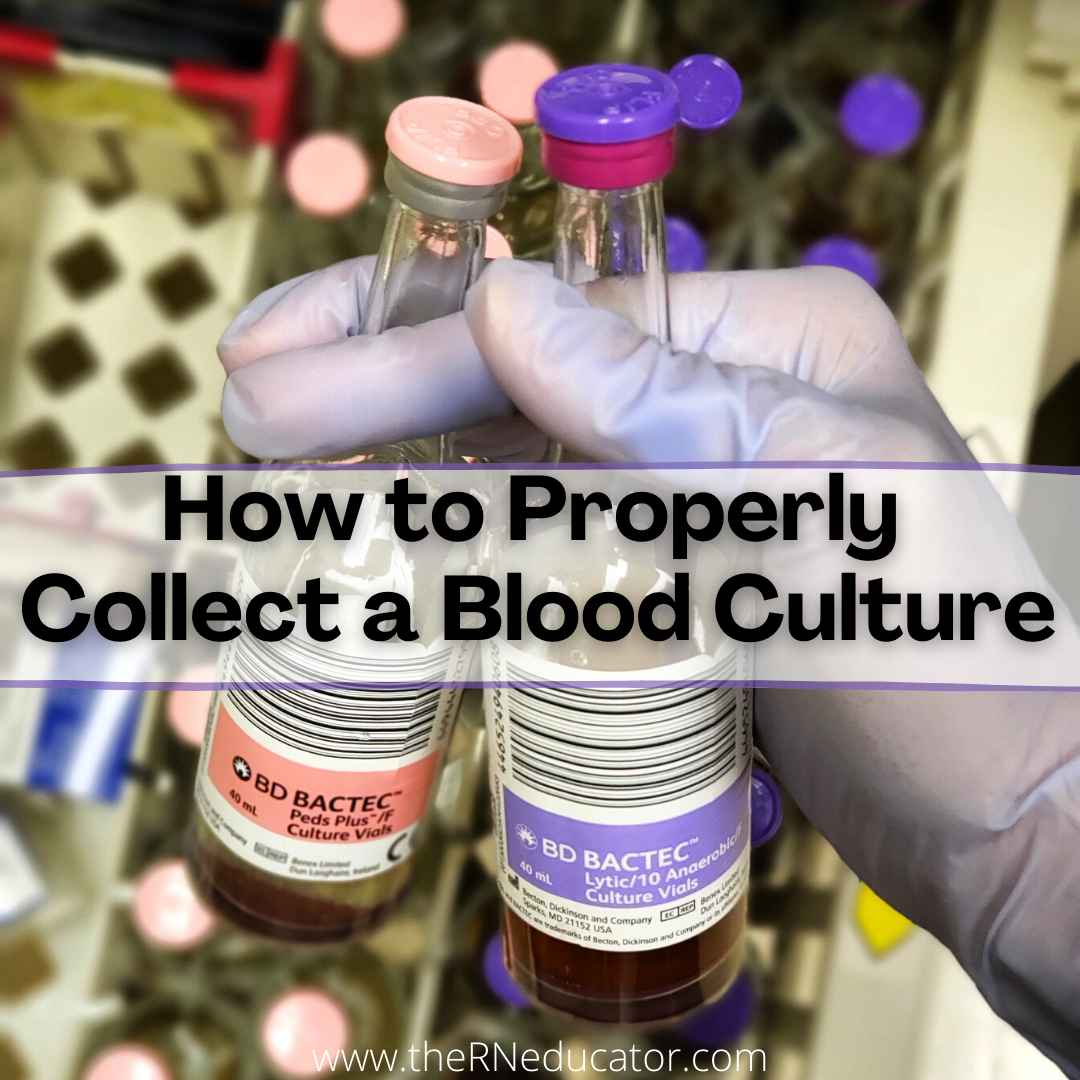How to Properly Collect a Blood Culture

Hello, friends! Welcome back to the blog. Today I have some great content to discuss with you, especially for you new nurses who are just starting clinical. We are talking how to properly collect a blood culture. What are blood cultures? When do you collect them? What do they tell us? Keep reading to find out more…
What is a blood culture?
Well, a blood culture is a laboratory test that is ordered to rule out a bloodstream infection or bacteria in the bloodstream, also known as bacteremia. It essentially is a glass bottle that contains culture media in order to allow bacteria in the bloodstream to grow. We will go over the steps on how to properly collect a blood culture a couple paragraphs below.
When do you collect a blood culture?
How to properly collect a blood culture is probably one of the most important steps in the blood culture process however, how do you know when a blood culture might be ordered? Well, if the patient is experiencing any of the following symptoms there is a chance a blood culture might be ordered.
- Fever
- Chills
- Leukocytosis – increased WBC count
- Septic shock
- Suspected endocarditis
- Prior to starting antimicrobial treatment (antibiotics)
Remember, the point of a blood culture is to rule out a bloodstream infection. Therefore, if any of these bullets above are present the provider may want to consider ordering a blood culture, especially if the patient does not appear well.
How do you collect a blood culture?
How to properly collect a blood culture may vary slightly from facility to facility, however, according to the CDC, there are general guidelines you must follow. I know in the organization I work for, we follow these guidelines step by step, especially since blood culture collections are monitored for contamination rates. Did you know the most common cause of blood culture contamination is inadequate skin preparation? This is why it is crucial to use aseptic technique when properly collecting a blood culture from your patient.
The very first thing you want to do when collecting a blood culture is to prepare. You want to ensure that you have all your supplies at the bedside and that you don’t have to call another nurse to grab something for you. Remember, once you collect the blood it should be transferred into the blood culture bottle immediately to prevent risk of contamination. Therefore, there is no time to be stepping in and out of the room. This will only increase the chances of cross contamination.
Supplies you’ll need for your blood culture collection
- Venipuncture needle (Butterfly for pediatrics)
- Gauze and bandaid
- Lab labels
- Specimen collection bag
- Tourniquet
- Blood culture bottles (anaerobic and aerobic)
- Alcohol pads
- Chlorhexidine (usually this comes as a small spongy scrub that you snap to release liquid)
- Vacutainer adaptor or blood transfer device (an adaptor you connect to the syringe and can safely transfer blood to vacutainers (vacuum sealed lab tubes including blood culture bottles) without risk of splash or contamination.
- In pediatric patients, I do not recommend connecting the blood culture bottle directly to the venipuncture tubing as you would do with other lab tubes. The negative pressure in the blood culture is very strong and can end up blowing your pediatric vein. You can collect blood with a syringe and transfer blood to blood culture bottles using aseptic technique.
Steps in collecting Blood Culture:
Step 1: Disinfect the bottle tops with an alcohol pad (should contain 70% isopropyl alcohol).
Step 2: Once you are ready to collect, clean site with chlorhexidine sponge. You will clean for a total of 30 seconds and allow area to completely dry (approximately 30 seconds).
Step 3: Proceed with collection of blood via venipuncture. For pediatric patients, 1-3 cc is sufficient for each aerobic and anaerobic blood culture set, according to the CDC, and 10-20 cc for an adult. Make sure to check with your facility as far as minimum blood collection as every facility requires or prefers a different amount.
Step 4: Once adequate blood is obtained remove tourniquet, needle, apply gauze and bandaid.
What do blood cultures tell us?
As stated above, a blood culture will tell us if there is bacteria in the blood stream. Over a few days, bacteria will begin to grow if present in the blood. Sometimes, however, it can take longer than just a few days. Once there is bacterial growth, we will able to know the type of bacteria that is growing which is very important in knowing proper treatment. Usually, a patient will be administered broad-spectrum antibiotics if they have clear signs and symptoms of infection at time of blood culture draw. The blood culture is tested for two things – culture & sensitivity. Once the blood culture comes back they will determine two things:
- Was their bacterial growth (culture aspect)? If so, is it resistant or sensitive to the antibiotics (sensitivity aspect)? Antibiotics might be changed at this point to a narrow-spectrum antibiotic which would be more specific to the bacterial growth.
- Blood cultures were negative, meaning there was no bacterial growth. Depending on the sign and symptoms of the patient and how they have progressed I have seen providers either advise patient to continue full course of antibiotics (especially to prevent resistance of spontaneously stopping antibiotics) or will advise them to stop them all together. It depends on many factors and the physician will ultimately make that call.
Important things to remember:
- Remember, if ordered, blood cultures should always be obtained PRIOR to start of antibiotics. This is because antibiotics can skew final blood culture results.
- If possible, obtain blood culture from new venipuncture site, not from existing central lines and definitely not from an existing PIV that still draws back blood. These lines could be contaminated and may not show true results of bloodstream infection.
- Unless, the provider wants to test the line itself for suspected catheter related blood stream infection (CR-BSI) and in that case you would label EXACTLY what site that blood culture came from. In this case, you would still obtain a separate venipuncture blood culture to ensure it isn’t a contaminant of the line versus an actual blood stream infection. Understand?
- When drawing blood, if you are collecting blood cultures and other labs make sure you collect blood cultures first before using blood for other lab tests. Blood cultures must always be collected first.
Hope you guys enjoyed this post and it helped you learn more about blood cultures. Your turn – tell me about a time you had to collect blood cultures on a patient (make sure to maintain HIPPA) and answer this: do you know what the most common pathogen of blood culture is?
Disclaimer: The above information is not to be used as medical advice. This is only educational. Keep in mind each facility is different and you should follow your facilities protocols.
’till next time,
The RN Educator
Share this:
Related Posts
What’s in a Pediatric Crash Cart? Nursing Students read NOW!
A pediatric crash cart is a mobile unit containing essential equipment and medications required for…
Share this:
How to Become a Confident Nurse
If you are anything like me, and let’s face it (like every nurse…



